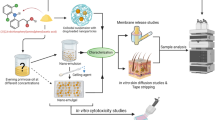Abstract
Diazepam, a lipophilic drug with CNS activity, serves here as a model to investigate the efficacy of SubMicron Emulsion (SME) as a novel transdermal vehicle. Diazepam was formulated in various topical regular creams and SubMicron Emulsion creams of different compositions. The different formulations were applied topically and protection against Pentamethylenetetrazole induced convulsive effects in mice was monitored. The efficacy of Diazepam applied topically in emulsion creams strongly depends on the oil droplet size and to a lesser degree - on the formulation composition and the oil type. Processing medium-chain-triglyceride (MCT) emulsion with a high-pressure homogenizer causes a drastic reduction in the droplet size, thereby significantly increasing the transdermal activity of Diazepam. In this case both the high-pressure homogenization and the presence of lecithin, an efficient dispersant, contribute to the effective droplet size reduction of below 1 micron, usually between 100–300 nm. The SubMicron Emulsions as vehicles for transdermal delivery of Diazepam generate significant systemic activity of the drug as compared with regular creams or ointments. Transdermal delivery of Diazepam via SME formulations is very effective, and the activity may reach the range of parenteral delivery. A single application of Diazepam in SME cream to mice skin provides pronounced transdermal drug delivery and prolonged protective activity up to 6 hours.
Similar content being viewed by others
REFERENCES
Y.W. Chien. Transdermal Drug Delivery. In: Novel Drug Delivery Systems, Marcel Dekker, Inc., New York, 1992, pp. 301–380
K. Egbaria, N. Weiner. Liposomes as a topical drug delivery system, Adv. Drug Del. Rev., 5:287–300 (1990)
D. Friedman, J. Schwarz and H. Aviv. Topical and transdermal delivery system utilizing submicron oil spheres. Patent Application PCT/US93/02800, publication number WO 93/18752 (30.09.93)
L.S. Goodman, A. Gilman (Eds.), The Pharmacological Basis of Therapeutics, 4th edition, The Macmillan Company, New York, 1971, p. 178
A. Rolland, N. Wagner, A. Chatelus, B. Shroot and H. Schaefer. Site-Specific Drug Delivery to Pilosebaceous structures using polymeric microspheres. Pharm. Res., 12:1738–1744 (1993)
J. Du Plessis, N. Weiner and D.G. Muller. The influence of in vivo treatment of skin with liposomes on the topical absorption of a hydrophilic and a hydrophobic drug in vitro. Int. J. Pharmaceutics, 103:R1–R5 (1994).
B.W. Barry. Lipid-protein-partitioning theory of skin penetration enhancement. J. Controlled Release, 15:237–248 (1991).
J. Hadgraft, K.A. Walters and R.H. Guy. Epidermal lipids and topical drug delivery. Semin. Dermatol., 2:139–144 (1992).
D. Quan, H.I. Maibach. An electron spin resonance study: I. Effect of Azone® on 5-doxyl stearic acid-labeled human stratum corneum. Int. J. Pharmaceutics, 104:61–72 (1994).
R.O. Potts, G.M. Golden, M.L. Francoeur, V.H.W. Mak, and R.H. Guy, Mechanism and enhancement of solute transport across the stratum corneum. J. Contr. Release, 15:249–260 (1991)
T. De Vringer. Topical preparation containing a suspension of solid lipid particles. European Patent Application EP 0 506 197 A1, Bulletin 92/40 (30.09.92)
R.H. Muller, C. Schwarz, A.Z. Mullen and W. Mehnert. Incorporation of lipophilic drugs and drug release profiles of solid lipid nanoparticles. Proceed. Intern. Symp. Control. Rel. Bioact. Mater., 21:146–147 (1994)
A.K. Banga and Y.W. Chien. Iontophoretic delivery of the drugs: Fundamentals, developments and biomedical applications. J. Control. Release, 7:1–24 (1988)
M.R. Prausnitz, V.G. Bose, R.S. Langer and J.C. Weaver. Transtissue molecular transport due to electroporation of skin. In: M. Blank (Ed.), Electricity and Magnetism in Biology and Medicine, San Francisco Press, San Francisco, 1993, pp. 122–124
D.I. Friedman, J.S. Schwarz and M. Weisspapir. Submicron Emulsion Vehicle For Enhanced Transdermal Delivery Of Steroidal And Non-steroidal Antiinflammatory Drugs. J. Pharm. Sci., in press
Author information
Authors and Affiliations
Rights and permissions
About this article
Cite this article
Schwarz, J.S., Weisspapir, M.R. & Friedman, D.I. Enhanced Transdermal Delivery of Diazepam by Submicron Emulsion (SME) Creams. Pharm Res 12, 687–692 (1995). https://doi.org/10.1023/A:1016255408348
Issue Date:
DOI: https://doi.org/10.1023/A:1016255408348




